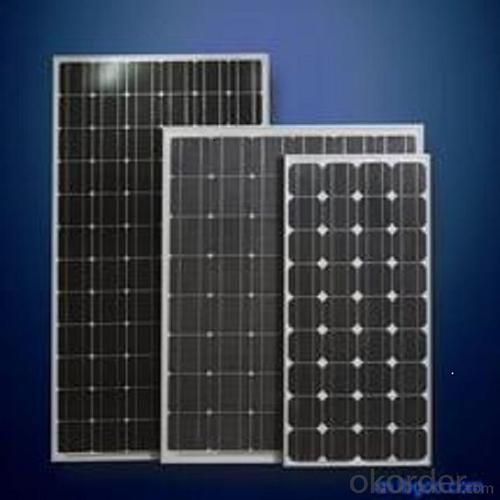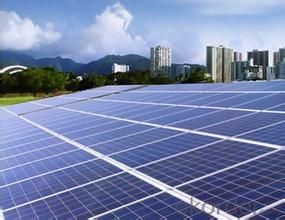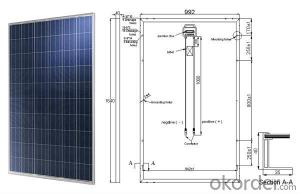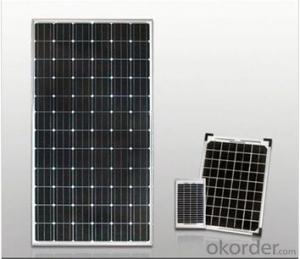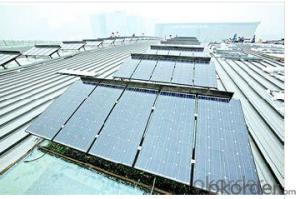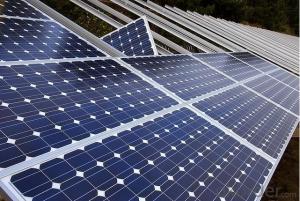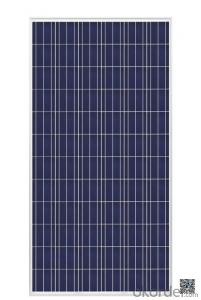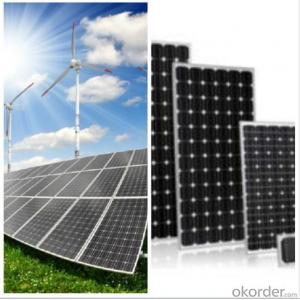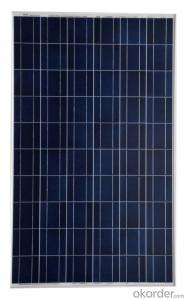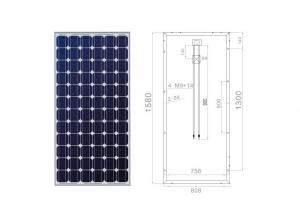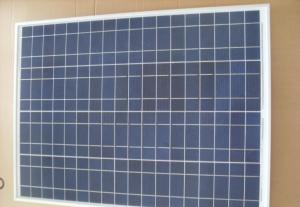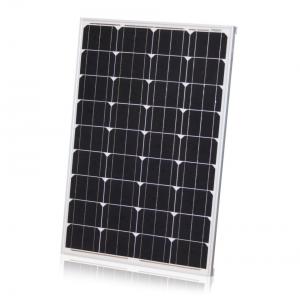Roof for Solar Panels:250W Solar Module Panel with Full Certificate
- Loading Port:
- Shanghai
- Payment Terms:
- TT OR LC
- Min Order Qty:
- 2600 watt
- Supply Capability:
- 26000 watt/month
OKorder Service Pledge
OKorder Financial Service
You Might Also Like
Specification
Product Description:
1.Structure of Solar Module Description
Solar panel refers either to a solar hot water panel, a common type of a solar thermal collector, or to one or more solar photovoltaics (PV) modules, electrically connected and mounted on a supporting structure.
A PV module is a packaged, connected assembly of typically 6×10 solar cells. Solar PV panels constitute the solar array of a photovoltaic systemthat generates and supplies solar electricity in commercial and residential applications. Each module is rated by its DC output power under standard test conditions, and typically ranges from 100 to 320 watts. The efficiency of a module determines the area of a module given the same rated output – an 8% efficient 230 watt module will have twice the area of a 16% efficient 230 watt module. There are a few solar panels available that are exceeding 19% efficiency. A single solar module can produce only a limited amount of power; most installations contain multiple modules. A photovoltaic system typically includes a panel or an array of solar modules, an inverter, and sometimes a battery and/or solar tracker and interconnection wiring.
2.Main Features of the Solar Module
1).High conversion efficiencies resulting in superior power output performance.
2).Outstanding power output even in low light or high temperature conditions
3).Optimized design for ease of soldering and lamination
4).Long-term stability,reliability and performance
GENERAL INFORMATION
The installation of PV modules requires a great degree of skill and should only be performed by a qualified licensed professional, including licensed contractors and licensed electricians. Please be aware that there is a serious risk of various types of injury occurring during the installation including the risk of electric shock. All CUSTOMER modules are equipped with a permanently attached junction terminal box that will accept variety of wiring applications or with a special cable assembly for ease of installation, and they do not require assembly.

GENERAL SAFETY
1. Consult local codes and other applicable laws concerning required permits on regulations concerning installation and inspection requirements.
2. Before installation a PV module, contact appropriate authorities to determine permit, installation and inspection requirements that should be followed.
3. Install PV modules and ground frames in accordance with applicable rules and regulations
4. PV modules should be installed and maintained by qualified personnel. Only installer/service personnel should have access to the PV module installation site.
5. No matter where the PV modules are installed, either roof mounted construction or any other type of structures above the ground, appropriate safety practices should be followed and required safety equipment should be used in order to avoid possible safety hazards. Note that the installation of some PV modules on roofs may require the addition of fireproofing, depending on local building / fire codes.
6. Please use PV modules with same cell size within series.
7. Follow all safety precautions of other components used in the system.
8. In order to avoid a risk of injury or electrical shock, do not allow anyone to approach the PV module if the person has little knowledge on PV module or on the measures that should be taken when PV modules are damaged.
9. Do not clean the glass surface with chemicals. Do not let water stay on the glass surface of PV modules for a long time. This creates a risk of white efflorescence(glass disease) which may result in the deterioration of energy generation.
10. Do not clean the glass surface with chemicals. Do not let water stay on the glass surface of PV modules for a long time. This creates a risk of white efflorescence ( glass disease ) which may result in the deterioration of energy generation.
11. Do not install the PV module horizontally. It may cause dirt or white efflorescence (glass disease) due to water.
12. Do not cover the water drain holes of the frame. There is a risk of frost damage when the frame is filled with water copulation.
13. When sliding snow load has to be considered, an appropriate measure has to be taken so that PV module frames on lower edge of PV modules will not be damaged.
14. Do not expose PV module to sunlight concentrated with mirrors, lenses or similar means.
15. Turn off inverters and circuit breakers immediately, should a problem occur.
16. In case the glass surface of a PV module is broken, wear goggles and tape the glass to keep the broken pieces in place.
17. A defective PV module may generate power ever if it is removed from the system. It may be dangerous to handle the PV module while exposed to sunlight. Place a defective PV module in a carton so PV cells are completely shaded.
18. In case of series connection , the maximum open circuit voltage must not be greater than the specified maximum system voltage. The voltage is proportional to the number of series. In case of parallel connection, please be sure to take proper measure to block the reverse current flow. The current may easily flow in a reverse direction.
- Q: Are solar panels easy to maintain?
- Yes, solar panels are relatively easy to maintain. They require minimal upkeep, with regular cleaning to remove dust and debris for optimal efficiency. Additionally, occasional inspections to check for any damage or shading issues may be necessary. Overall, the maintenance requirements for solar panels are straightforward and manageable.
- Q: How long does it take to recoup the investment in solar panels?
- The length of time it takes to recoup the investment in solar panels can vary depending on factors such as the cost of the system, available incentives, electricity usage, and local solar conditions. On average, it usually takes between 5 to 10 years to recover the initial investment through energy savings. However, with the declining costs of solar panels and the potential for government incentives, this payback period may be shorter in certain cases.
- Q: Is it possible to store energy from solar panels for night?
- Why pay thousands of dollars for solar energy ($27,000 average cost) when you can build your own solar panel system for just a fraction of the retail cost. You can build a single solar panel or you can build an entire array of panels to power your whole house. Some people are saving 50% on their power bill, some people are reducing their bill to nothing. But what’s most impressive is that just by following these instructions some are even making the power company pay them!
- Q: We want make solar panel for our home use. but we have no any right idea how we can make it. we want to make it with cheap prices.we also want to know the proper size of solar panel.where we can take help about making a solar panel
- All you need to do is to learn how to build solar panel to produce your own electrical energy through solar panels. These solar panels take and keep the energy from the sun and turn it into usable electrical energy that we can use every day in our ordinary lives. Generally, the majority of people that knew about solar panels think that they won't benefit from its use because they just work in sunny areas. That isn’t the case. In fact, the new generation of solar panels can produce a lot of electrical energy even on rainy weathers. Learning how to build solar panel is very easy: first they need to be installed (most of the time, on the roof of homes) and then they take the energy from the rays of sunshine and convert it from solar energy to electrical energy. Solar panels must be kept from shading, as shaded cells draw energy for themselves from other cells. Things you need to know: . Solar panels using monocrystalline cells have high conversion efficiency, and take up less space, but lack shade protection. 2. Solar panels using polycrystalline cells have even higher conversion efficiency, take up even less space, but still lack shade protection. 3. Solar panels using amorphous silicon cells have lower conversion efficiency, and take up more space, but do have shade protection. This can be especially important on a sailboat. Once you have determined the size and number of solar panels needed, you will be better able to determine where they will be placed. The best places depend on the roof's length and size of the panels. Take your time and think it through. The simple answer to how to build solar panel is none other than the sun. Select locations that will get maximum sunlight without shaded spots. In placing solar panels, consider the use of extra bars/braces to secure the panels. You obviously want them to remain stable.
- Q: How do solar panels affect the property's community engagement?
- Solar panels can have a positive impact on a property's community engagement by promoting sustainable practices and sparking conversations about renewable energy. Solar panels serve as a visible symbol of a property's commitment to reducing carbon emissions and reliance on fossil fuels, which can inspire and encourage others in the community to adopt similar eco-friendly practices. Additionally, solar panels can be used as an educational tool, offering opportunities for community members to learn about solar energy and its benefits, fostering a sense of environmental awareness and collective action.
- Q: For those solar panels that you install on your rooftops, do they generate electricity when it's cloudy? And if yes, how much electricity does it generate compared to sunny days? For example...like only 25% electricity generated compared to sunny days?
- No, silicon photovoltaics reacts to a very specific frequency of infrared light which matches the bandgap energy of it's outer electron shell. This frequency is reflected by clouds. However, thermal solar collectors such as evacuated tube collectors can function under cloudy skies albeit at a lower rate and there is at least one hybrid photovoltaic and thermal panel designed to take advantage of this.
- Q: I found portable solar panels used for boats etc. and was wondering how I could effectly use them for my home instead. If you have used them in the past, please tell how they worked (good or bad).
- well i highly dout that solar panels ued for boats and rvs will work the same for your house, because your house requires more energy to run then a solar power can give.
- Q: Can solar panels be used to power streetlights or outdoor lighting?
- Yes, solar panels can be used to power streetlights or outdoor lighting. Solar-powered streetlights or outdoor lighting systems consist of solar panels that capture sunlight and convert it into electricity, which is stored in batteries. This stored energy is then used to power the streetlights or outdoor lighting during the night or when there is insufficient sunlight. Solar-powered streetlights offer a sustainable and cost-effective solution for outdoor lighting, reducing energy consumption and carbon emissions.
- Q: What is the maintenance cost of solar panels?
- The maintenance cost of solar panels is generally low. Routine maintenance involves cleaning the panels periodically to remove dirt or debris, which can be done by the owner or a professional cleaning service. Additionally, inspecting the panels for any signs of damage or malfunctioning is recommended. Other than these basic maintenance tasks, solar panels do not require much ongoing maintenance and have minimal operational costs.
- Q: trees vs solar panels who would win?
- hmmmmm trees would squash em and solar pannels would electric cute em............... :)
Send your message to us
Roof for Solar Panels:250W Solar Module Panel with Full Certificate
- Loading Port:
- Shanghai
- Payment Terms:
- TT OR LC
- Min Order Qty:
- 2600 watt
- Supply Capability:
- 26000 watt/month
OKorder Service Pledge
OKorder Financial Service
Similar products
Hot products
Hot Searches
Related keywords


